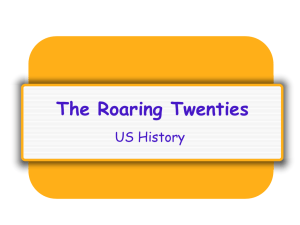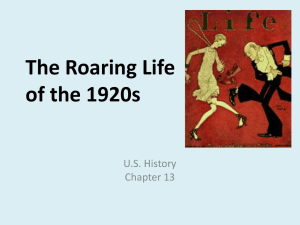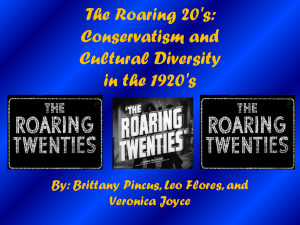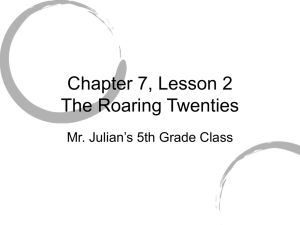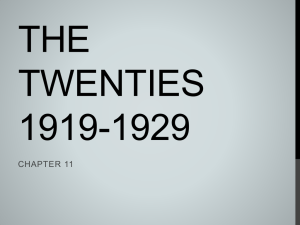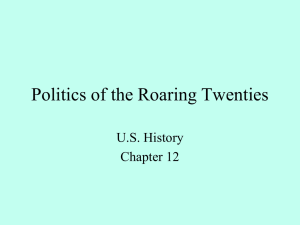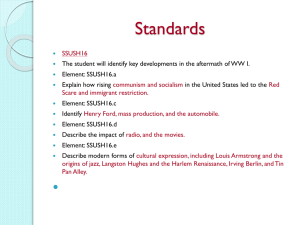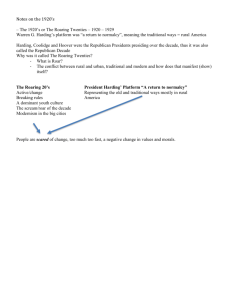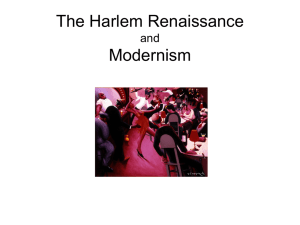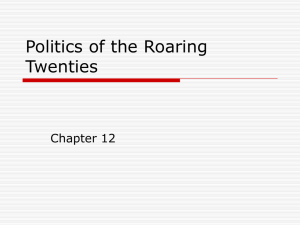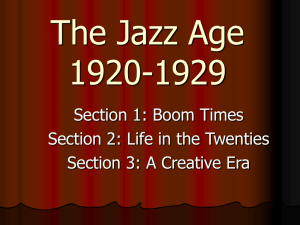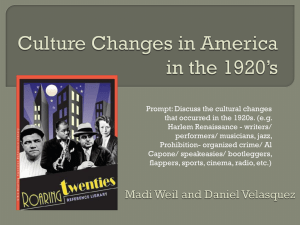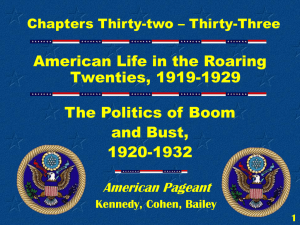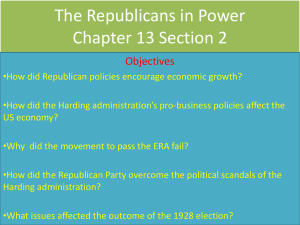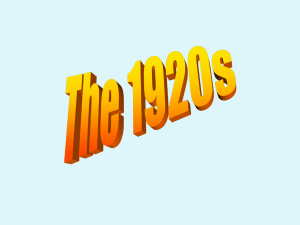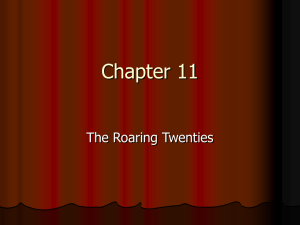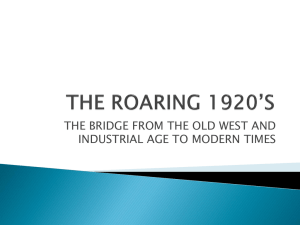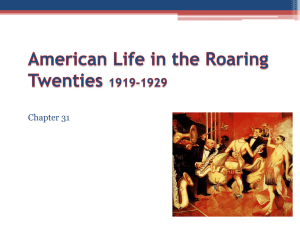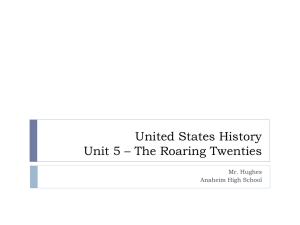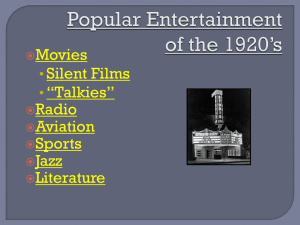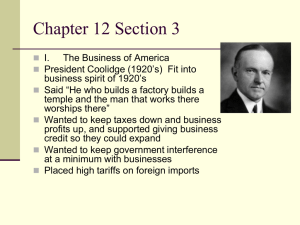notes
advertisement
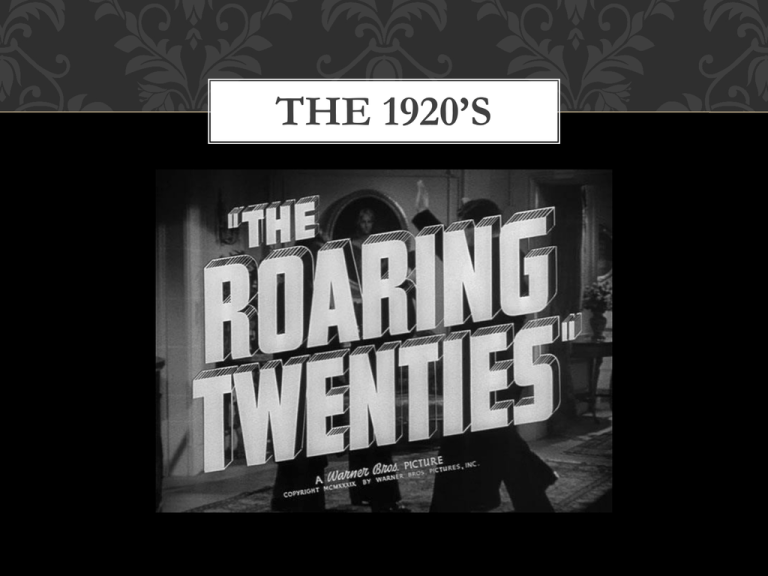
THE 1920’S BOOMING ECONOMY SLO’s • Henry Ford moved America forward economically • SW describe how the consumer revolution and bull market came to be • How are the effects of the economic boom on urban and rural similar/different? SLO’s • Explain the impact of Henry Ford and the automobile • Analyze the consumer revolution and the bull market • Compare the different effects of the economic boom on urban and rural America. BOOMING ECONOMY Terms and People (p. 324) • • • • • • • • • Henry Ford mass production Model T scientific management assembly line consumer revolution installment buying bull market buying on margin BOOMING ECONOMY Summary: • Through Henry Ford’s innovation of the automobile, economic growth in the 1920’s boomed due to the additional resources and freedom it lent to the American public. • Mass production was not an innovative idea at the time • Assembly lines of cars required the assembly of thousands of parts • The boom in the automotive industry stimulated growth in other industries related to car manufacture or use. • It also caused additional economic effects: ground, railroad, and trolleys declined. • New sense of freedom & prosperity BOOMING ECONOMY 1 9 th C e n t u r y M a s s P r o d . Fo r d A s s e m b l y L i n e s BUSTLING ECONOMY Summary • As American began to progress thru the 1920’s, Americans began to buy more products because of innovative advertising schemes and a new means of buying “credit” which allowed the market to soar and change the attitude towards consumption in the U.S. • Widespread availability of electrical power supported the consumer revolution • Advertising and credit played its part in selling more products • More and more Americans put their money into stocks to get rich quick due to a bull market BULL VS. BEAR BULL BEAR CITIES, SUBURBS, AND COUNTRY Summary • Although people were flocking to the city and people w/in the confines of the city were prospering, farmers outside of it were not. • The economic boom did not affect all parts of the nation equally. While urban and suburban areas prospered, rural Americans struggled. • Immigrants, farmers, and an African American migration came to cities. • Suburbs began to pop up due to mass trans • Farm income declined and wealth was not well distributed PAIRED ACTIVITY • Write a paragraph summarizing the reasons for the historical viewpoint that Henry Ford was one of the chief makers of the modern world. BUSINESS OF GOVERNMENT SLO’S SLO’s • Pinpoint the way Harding and Coolidge promoted the growth of businesses • Talk about the shady events that went down on Harding’s watch • How did the U.S. affect the world as a whole during the 20’s? • Analyze how the policies of Presidents Harding and Coolidge favored business growth. • Discuss the most significant scandals during Harding’s presidency. • Explain the role that the U.S. played in the world during the 1920’s. KEY TERMS AND PEOPLE (P. 330) • • • • • • • Andrew Mellon Herbert Hoover Teapot Dome Scandal Calvin Coolidge Washington Naval Disarmament Conference Kellogg-Briand Pact Dawes Plan HARDING ADMINISTRATION HARDING ADMINISTRATION Summary • President Harding’s stance on economic growth was that of a “hands-off ” and laid back approach. He promoted internal growth and forced Americans to buy domestic. Harding was also surrounded and influenced by a close-knit group of friends that made decisions that benefited only them and not the U.S. citizens. • Took a laissez-faire approach economics and favored giving power back to the business owners. • Hiked tariffs on imports • Ohio Gang COOLIDGE PROSPERITY Summary • Although the nation was prospering financially under Coolidge’s leadership, the U.S. was facing more underlying problems that needed attention and concern. • Aspired to reduce national debt, trimming federal budget, and lowering taxes to give incentives for businesses=booming economy. • Farmers struggled due to prices of goods • Labor unions demanded higher wages • African Americans faced discrimination AMERICA’S ROLE IN THE WORLD Summary • Post WWI, the global community recognized that they couldn’t afford another war of that magnitude so the different nations attempted to implement different protocols to ensure global peace. At the same time, relations w/ GB, France, and Germany were hindered due to the lack of war debt being paid off. • Nations were attempting to ensure that there would never be another World War • Washington Naval Disarmament • Kellogg-Briand Pact 1928 • GB and France owed U.S. war debt • Germany owed GB and France • Dawes Plan SOCIAL AND CULTURAL TENSIONS SLO’s • Compare economic and cultural life in rural and urban America. • Discuss the changes in U.S. immigration policy • Analyze the goals and motives of the Ku Klux Klan in the 20’s • Discuss the successes and failures of 18th Amendment KEY TERMS AND PEOPLE • • • • • • • • • • modernism fundamentalism Scopes Trial Clarence Darrow quota system Ku Klux Klan Prohibition 18th Amendment Volstead Act bootlegger TRADITIONALISM /MODERNISM CLASH • • • • • Modernism Openness toward social change and new discoveries of science Mastery of mathematics and language –high school/college Fundamentalism Scopes Trial of 1925—debate of evolution Issue: Darwin’s theory of evolution that complex forms of life, human beings, had developed from simpler forms of life Traditionalism • More traditional view of science, religion, and culture • Muscle, endurance, and knowledge of crops--education SCOPES TRIAL OF 1925 RESTRICTING IMMIGRATION Summary Nativists wanted restrictions of access of immigrants into the U.S. by implementing a quota system for each country to match a certain percentage of a country’s population. Since Mexicans productively contributed to local economies the quota system did not pertain to them. • Nativists pushed for immigrants that couldn’t read or write their own language not be allowed into the U.S. • Quota system • Mexicans contributed to the local economies of the Southwest—quote system did NOT apply to Mexicans THE NEW KU KLUX KLAN Summary With the culturally changing look of the U.S. in the 1920’s, the KKK opposed cultural diversity and was met w/ resistance by organizations that welcomed those changes. • Rural Americans saw the country become increasingly urban and their own position in the nation slip in relative importance—many lashed out • Most were in the South, but had branches in the Midwest, Northeast, and West • NAACP, Jewish AntiDefamation League embraced national diversity THE NEW KKK PROHIBITION AND CRIME Summary The 18th Amendment was established and enforced through the Volstead Act, but certain Americans found ways to illegally sling alcohol which resulted in heightening organized crime. • 18th Amendment—forbade manufacture, distribution, and sale of alcohol • Volstead Act—enforced 18th • Bootleggers—sold illegal alcohol to consumers • Al Capone—most famous criminal during Prohibition Era • Organized crime boomed PROHIBITION AND CRIME EXIT SLIP • How did the two sides in the Scopes Trial represent conflicting value systems? What did each side value most? A NEW MASS CULTURE Learning Outcomes 1. Trace the reasons that leisure time increased during the 1920’s 2. Discuss the advancements of women in the 1920’s 3. Analyze the concept of modernism and its impact on writers and painters 4. Trace the developments and impact of jazz 5. Discuss the themes explored by writers of the Harlem Renaissance KEY TERMS AND PEOPLE P. 343 • • • • • • • • • Charlie Chaplin The Jazz Singer Babe Ruth Charles Lindbergh Flapper Sigmund Freud “Lost Generation” F. Scott Fitzgerald Ernest Hemingway NEW TRENDS IN POPULAR CULTURE Summary • As American popular culture began to evolve, Americans looked to different means of entertainment like going to the movies and listening to the radio. • The work week was down to 5 days a week and salaries and wages were on the rise. • Americans looked to a new form of entertainment— movies • Charlie Chaplin/Rudolph Valentino • Phonograph and radio also became powerful instruments of mass popular culture. AN AGE OF HEROES Summary • As Americans looked to sports for heroes to instill a sense of hope post WWI, there were a number of athletes and historical figures that provided that escape. • Hollywood’s chief rivals for the creation of heroes were the baseball parks, football fields, and boxing rings. • Babe Ruth—baseball • Red Grange—football • Jack Dempsey—boxing • Bobby Jones—golf • Charles Lindbergh “Lucky Lindy”—Spirit of St. Louis WOMEN MAKING STRIDES Social Changes Political Changes • More liberated • 19th Amendment— • Wore dresses w/ gave women the shorter hemlines right to vote. • More make-up • Work in reform • Danced movement, run for • Flappers office, fight for laws • Women wanted more to protect women control of their lives and children in the and got it! workplace • Primary goal—pass the Equal Rights Amendment Economic Changes • • • • Entered workforce Charitable work Joined clubs Vacuum cleaners and irons took some of the drudge out of the labor FLAPPER MODERNISM IN ART AND LITERATURE Summary • As the American culture was rapidly changing, American writers began to think outside the box by thinking more abstractly and pushing the boundaries of what was previously accepted during the “Victorian Era”. • WWI altered the way writers and artists viewed the world, changed the way they approached their craft, and inspired them to experiment w/ new forms and fresh ideas. • Sigmund Freud—psychologist • F. Scott Fitzgerald—novelist (The Great Gatsby) • Ernest Hemingway--novelist FREUD/THE GREAT GATSBY THE HARLEM RENAISSANCE Learning Outcomes 1. Trace the development and impact of jazz 2. Discuss the themes explored by writers of the Harlem Renaissance. A NEW “BLACK CONSCIOUSNESS” Summary • Although African Americans began to migrate to more urban areas for employment and a better way of living, there was still a sense of racism everywhere. When Marcus Garvey advocated for a separation of races he, at the same time, instilled a sense of pride amongst AA’s and helped the race move forward socially. • • • • • African Americans who left the South dreamed of a better future. In northern larger cities AA had a growing political voice where there was more of a middle to upper class. Harlem became the focal point for the aspirations of thousands of AA Marcus Garvey—advocated the separation of the races Instilled a sense of pride amongst black people and their culture THE JAZZ AGE Summary • Jazz music was a vital part of the Prohibition Era that blended a sense of pride and an avenue of expression amongst African Americans. • Jazz is truly a form of indigenous American music based on improvisation. • Louis Armstrong became the ambassador for jazz • Bessie Smith • Apart of the 1920’s and Prohibition Era • Demonstration of the depth and richness of the AA heritage. LOUIS ARMSTRONG/BESSIE SMITH HARLEM RENAISSANCE Summary • The Harlem Renaissance brought about a different means of expression for African Americans through the usage of poems and stories. • The flowering of AA culture became known as the Harlem Renaissance. • “New Negro” suggested a radical break w/ the past. • Explored the pains and joys of being black in America. • Claude McKay showed ordinary AA’s struggling for dignity and advancement in the face of discrimination and economic hardships. • Langston Hughes—most powerful writer LANGSTON HUGHES
